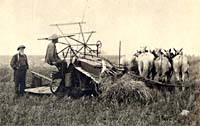
Between the colonial
days of America to the watershed year of 1934, when President Franklin
Delano Roosevelt signed the Agricultural Adjustment Act in an attempt
to relieve the economic stress of owner-operated farms, a gradual change
in approach and attitude towards our farmlands, the nation's heartland,
took place. It reflected a change from a stewardship ethic, an agrarian
philosophy, to one based on efficiency, commerce, and productivity.
The Agrarian
Tradition
The agrarian tradition corresponded to the Jeffersonian ideal of the
"independent yeoman farmer" and blended two traditions. The
first tradition, "farming-as-a-way-of-life," emphasized the
intrinsic goodness of dealing with the land. Farming was a contributor
to the development of responsible citiziens through the encouragement
of social virtue, economic prosperity, and democracy. Agriculture, the
nation's basic industry, reflected America in microcosm.
The Efficiency
Tradition
The second tradition was known as the efficiency tradition, the productivity, or the entrepeneurial
tradition. It corresponded to the pull-yourself-up-by-your-bootstraps success
stories of Horatio Alger and the advice of Benjamin Franklin
on the rewards of persistence and perseverance in Poor Richard's
Almanac. Farming was an occupation, a way of making a living that
was "instrumentally good" in that it contributed to material
well-being. Land was a means to an end, a resource to be gainfully and
efficiently employed to promote the best future for oneself and for
the nation.
Consequences
of Attitude Change to Small Farms
These two
traditions were intertwined in a Gordian Knot, each expressing something
of the American experience and validating images that Americans held
of themselves and the nation. New methods of industry and modernization
led to the great transformation of farming and rural life that today allows room for both small farms and corporate farming. This is exemplified
on the plains of Iowa and California's Central Valley.
Even as pioneers
such as "Grandpap" Sadorus were migrating to the Illinois
prairies in the early 1800s, a new system of manufacturing was being
developed on the east coast that emphasized mass production, low cost,
and interchangeability of parts. This system created a variety of products,
many of which were used on farms to increase the productivity of laborers
in planting and harvesting. An increasing percentage of the population
found employment in this new manufacturing sector and a decreasing percentage
in crop production. Specifically, in 1800, the percentage of the population
involved in agriculture was 75 per cent. By 1900 it had decreased to
less than 40 per cent. In 1900, the number of Illinois farms reached
its peak at 260,000, with the average size being 125 acres.
The 104-acre Sadorus
family farm was sold in 1917, coinciding with the end of World War I,
when the peacetime economy made prices fall. Small farmers made less
money. Loans were harder to repay. Selling the family farm became increasingly
common as larger numbers of farm children left farming to pursue new
career opportunities in manufacturing, medicine, law, science, government, and entertainment.
What did the loss
of the farm mean in a human sense? For some farmers, it was an opportunity;
for others, it was a difficult but reasonable decision reached after
careful consideration. For the unluckiest, like Frank Sadorus, it was
a heartbreaking decision made against their will by others. Some did
not adapt to change as well as others. What happened to those who could
not, or would not, make a transition to a new career or retirement?
Failure to
Adapt
The death of Frank's father on June 17, 1911, was in Frank's own words,
"a turning point in our lives." Within a year Frank had all
but stopped photographing (the few images that exist from between 1911 and
1917 are dark and foreboding). At some point, the family began to debate
selling the farm. Frank alone resisted. (An inscription on the back
of an image of the farmhouse dated 1912, he penned, "Home Sweet...Damn.")
In 1917, when
the estate was settled and the farm was sold, his sister, Mary, and
his brother, Elmer, retired from farming to build a new house in town
with their mother Phoebe. Frank moved into a two-room cottage on the
edge of town and packed away his photographic equipment. He was away from his
family and the farm for the first time at age 37.
Within three months
he was committed to the Kankakee Mental
Asylum by his mother, brother and sister. The court official described him as "troubled with delusions
and hallucinations with pronounced tendency to worry... primarily concerned
that someone was trying to harm him." The examining physician described
him as "well-mannered" with a kind disposition. According
to the records, his "symptoms" appeared a week before the
commitment. He remained at the asylum until his death seventeen years
later.
It was not uncommon
at the time for "difficult" or "odd" family members
to be put away conveniently in institutions. In 1921, there were 27,514
inmates under the Department of Public Welfare. While 17,596 were classified
as insane, other categories of people institutionalized included the
feeble-minded, epileptics, the deaf, the blind, prisoners, and old soldiers.
Related Activities:
Farm Jobs (html) (pdf)
Farms in Art (html)
(pdf)
Farm Mechanization
(html)
(pdf)

